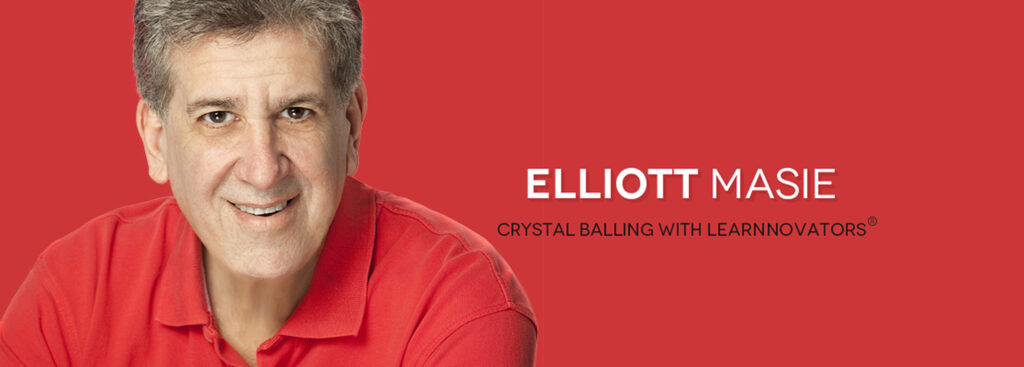ABOUT ELLIOTT MASIE:
Elliott Masie is the Host and Curator of many Learning & Development Seminars, Labs, and Conferences over the past 28 years. He is a provocative, engaging and entertaining researcher, educator, analyst and speaker – focused on the changing world of the workplace, learning and technology.
He heads The MASIE Center, a Saratoga Springs, NY think tank focused on how organizations can support learning and knowledge within the workforce. He leads The Learning CONSORTIUM, a coalition of 230 global organizations cooperating on the evolution of learning strategies, including Amazon, Walmart, American Express, General Electric, McDonald’s, General Motors and Fidelity Investments.
He is the editor of Elliott Masie’s Learning TRENDS, an Internet newsletter read by over 52,000 business executives worldwide, and a regular columnist in professional publications, including CLO Magazine. He is the author of 12 books, including the ASTD/MASIE Center’s Big Learning Data.
Elliott’s professional focus has been in the fields of corporate learning, organizational performance and emerging technology. He has developed models for accelerating the spread of knowledge, learning and collaboration throughout organizations. Elliott is acknowledged as the first analyst to use the term ‘eLearning’ and has advocated for a sane deployment of learning and collaboration technology as a means of supporting the effectiveness and profitability of enterprises.
Elliott serves as an advisor to a wide range of government, education and non-profit groups. He has served on the Board of Trustees of Skidmore College, as a member of FIRST Robotics Board of Directors and the CIA University Board of Visitors. He has served as a pro-bono advisor to the Department of Defense and on the White House Advisory Council on Expanding Learning Opportunities.
Elliott is known as a highly approachable speaker and trainer, blending humor, applicable stories of best practice and high levels of audience involvement. Over the past thirty-five years, he has presented programs, courses and speeches to over 2,100,000 professionals around the world. He lives in Saratoga Springs, owns thoroughbred horses, and is a producer/investor in Broadway shows including the TONY Award Winning Kinky Boots and An American in Paris, as well as The Prom, The CHER Show, Anastasia, The Play that Goes Wrong and SpongeBob The Broadway Musical.
ABOUT THIS INTERVIEW SERIES:
Crystal Balling with Learnnovators is a thought-provoking interview series that attempts to gaze into the future of e-learning. It comprises stimulating discussions with industry experts and product evangelists on emerging trends in the learning landscape.
Join us on this exciting journey as we engage with thought leaders and learning innovators to see what the future of our industry looks like.
THE INTERVIEW:
1. LEARNNOVATORS: We, at Learnnovators, are great fans of your work, Elliott! You are considered a guru in the world of training for your expertise in learning technologies, and your approaches and methods for identifying how the new learning technologies can deliver real value to L&D. We have been following you over the years to keep track of your take on the changing world of workplace learning. We are honored to have you with us today to explore the past, present and the future of learning, Sir!
How has your journey been so far?
ELLIOTT MASIE: For almost 50 years, I have been honored to be an experimenter and analyst in the learning field. As a deeply curious human being who is also a nerd, the connection of learning, behavior and technology have been my passion. I am thrilled to have been and continue to be helping to push, challenge and evolve both the learning field but also the larger workplace productivity ecosystem.
2. LEARNNOVATORS: What are the most pressing learning challenges corporations are facing today?
ELLIOTT MASIE: People are changing. The workplace is changing. Technology is changing. And, our styles and expectations for learning and knowledge is changing. The pressing challenge is to “keep up” with the evolution of our workforce and the business world in ways that support daily learning, knowledge and readiness. It is not about finding a new learning technology or process. It is about stretching our approaches to meet a changing workforce and workplace.
3. LEARNNOVATORS: Can you also share some of the innovative ways in which these global organizations are successful in finding solutions to their workplace learning issues?
ELLIOTT MASIE: Here are 3 ways: 1) Evolving the format from classroom and e-learning to more targeted and “right now” experiences and segments; 2) Focusing on the “workflow” as the key focus – by adding knowledge, support and assessment into the flow of work of our employees; 3) Leveraging data to push and shape the learning process. Data and evidence change how we design, assess and target learning.
4. LEARNNOVATORS: What do you think are the disruptive technologies that are presently influencing workplace learning?
ELLIOTT MASIE: Mobile phones, Search Engines, Community Connectors and HR Systems.
5. LEARNNOVATORS: What are some of the interesting learning experiments that you do at MASIE around these technologies?
ELLIOTT MASIE: Leveraging smart speakers (Siri, Alexa), AI and Machine Learning, Immersive Technology and Video Based Real Time Coaching.
6. LEARNNOVATORS: How are we changing as learners? Can you share your observations and findings with our readers please?
ELLIOTT MASIE: Learners are no longer memorizing stuff. Learners are more interested in having navigational readiness than stored knowledge. Learners want to validate new info from second voices or sites. And, learners are more focused on addressing Pain, Change, and Now.
7. LEARNNOVATORS: You are acknowledged as the first analyst to use the term ‘e-Learning’ way back in mid-1990s. As we understand, the definition of e-learning has evolved quite a bit along these years. You say, “The “e” in “e-learning” today doesn’t stand for “electronic” since this characteristic is a no-brainer; rather, it stands for “everyone”, “everywhere”, “every time”, “evolving”, “effective”, “efficient”, “engaging”, and “entertaining”. You consider the internet and the mobile phones as the crucial turning points for this development. However, we believe that e-learning hasn’t yet started leveraging the incredible power of the internet or the web. For example, we still do not see successful e-learning implementations that are powered by real-time interactive and collaborative learning modalities. When it comes to e-learning, we are all alone locked up inside a dreaded silo, whereas the games that keep our kids as well as adults engrossed today are ‘real-time’ and ‘multiplayer’. Not much has changed with respect to e-learning in all these years compared to the advancements that have happened in other aspects of our lives.
What are your views on this?
ELLIOTT MASIE: Actually “e” learning – as you frame it, HAS changed. Everyday, we are using search, text and connection to find just-in-time knowledge and interact with others. Sadly, the “published” aspects of e-learning are not as interactive or engaging. We have to move from being publishers to creating engagement and challenge to individuals and groups.
8. LEARNNOVATORS: What would be your suggestions for e-learning to step up?
ELLIOTT MASIE: eLearning will continue to evolve. The “e” will go away. People on vacations are using technology to enhance and extend their travel experiences. It is stretching the tech, content and community that is already there. But, we don’t talk about it as e-Tourism. Accept that tech and people will evolve and learning will flow with that process.
9. LEARNNOVATORS: What, according to you, is the potential for Conversational (dialog-based) Learning in this age of chatbots? What role do you foresee for chatbots as Learning Guides or Agents in bringing learning to where employees are (into their flow of work)?
ELLIOTT MASIE: Yes and Yes! There is research from the past 100 years that validates that conversation and dialogue are part of how learners have cognitive rehearsal around new content or skills. Chatbots, smart speakers and other agents will be a major force. I predict, though, that they will come from, and be governed by, business units that are not Learning and Development groups.
10. LEARNNOVATORS: What role do you foresee for chatbots to break the silos of our traditional course designs? Would you agree that our designs need to allow today’s users to navigate the learning experiences we craft for them in more ‘natural’ ways, such as through conversations, in place of the traditional Previous & Next buttons?
ELLIOTT MASIE: Chatbots are curiosity-based tools. As such, they will be at the heart of next generations of learning technology. But, they won’t be separated. I should not have to launch a chatbot – why not just talk to my screen or mobile device and get the responses in the format and location of preference.
11. LEARNNOVATORS: How do you think chat bots are poised to transform L&D with respect to both training (Bots as trainers) and managing training (Bots that make the LMS ‘invisible’)?
ELLIOTT MASIE: They will be part of the process. I do not think the chatbot alone is the answer – it is a framework that has a powerful chatbot and more.
12. LEARNNOVATORS: What do you think should learning leaders keep in mind while experimenting with this evolving technology to make ‘artificial teachers’ or ‘virtual teaching assistants’?
ELLIOTT MASIE: We will see global innovation in AI and Machine Learning. It will happen on the coaching side, on the assessment side and eventually on the content creation or targeting side. Let’s look at these as part of a multi-year experiment in K-12, higher education, shopping, healthcare, recreation and also corporate learning. It is not a hype or an overstated product. It will be a force to extend, personalize and evolve the workflow and knowledge process.
13. LEARNNOVATORS: Will AI take over teachers or trainers and make them jobless? How should teachers and trainers upskill themselves to avoid getting outdated?
ELLIOTT MASIE: AI will impact the overall workplace. Things that are routine will be automated and data-driven tasks will be automated. The training roles will change alongside the workplace roles.
14. LEARNNOVATORS: We’ve never been more convinced about the role of learning designers in the learning process. However, we are also amazed at the power of Artificial Intelligence (AI) to transform learning, as well as learning design. In the context of serious discussions around ‘Singularity’ (moment when AI overtakes us human beings), a smaller question relevant to us could be, “Will AI replace our learning designers?” However, like many others out there, we too believe that the role of learning designers is going to be redefined, if not outdated.
What would be your advice to our learning professionals to remain relevant in this scenario?
ELLIOTT MASIE: Be experimenters. Be learners. Be excited and cynical at the same moment. Change is not a WOW and new product. It is a process of experimentation and failure and requires change agents to be using, pushing and hype-busting.
15. LEARNNOVATORS: Back in the day, formal learning was the only source of information or expert knowledge. However, that’s not the case today. Google and YouTube have changed the game. The focus has shifted from ‘owning knowledge’ to ‘knowing how to access information to construct knowledge’. But today’s e-learning continues to be tedious. We google first for ‘helpful resources’ on the topic, and maybe check with our peers at the workplace next if required.
What can learning designers learn from this for looking at learning design ‘beyond learning’?
ELLIOTT MASIE: Separate the compliance requirements that may need more traditional learning models. But, I like to shift our attention from the format of delivery to using assessment as our compliance focus. If the learner can show they are ready to do a task – they become more agnostic about the pathway to that readiness.
16. LEARNNOVATORS: What would be the best approach to move away from ‘learning’ to ‘resources for performance support’?
ELLIOTT MASIE: Make performance support part of the product, process or workflow. As I type my ideas for this article, the spellchecker does a real-time set of nudges for any typos. I don’t have to go to spellchecker or even log in. It is part of my word processor and the eco system of how I write.
17. LEARNNOVATORS: Would you agree with David James, Chief Learning Officer with Looop and an experienced Talent Management expert, who advocates for a purpose-built ‘Resources first’ approach that respects the intelligence and the prior experience of learners in place of the conventional ‘e-learning first’ approach for immediate effectiveness at work?
ELLIOTT MASIE: 1000% agree. We insult our audience when we ignore their existing knowledge. Significant savings can happen when we start with what they don’t know – and leverage current knowledge as an accelerator to readiness.
18. LEARNNOVATORS: What strategies would you recommend for L&D to scale up from ‘instructional design’ to ‘learning experience design’?
ELLIOTT MASIE: Time for a new model of L&D staff. I see learning design as being more user experience focused and a skillset more than a career. Let’s bring talented people with workplace expertise into learning for a stint in their career and send them out as part of our circle of influences. And, add data analytics, UX and assessment skills to the mix.
19. LEARNNOVATORS: Technology, in addition to offering a plethora of new tools that are artificially intelligent, has helped make our existing teaching and learning tools smarter. Of late, it has also been powering up the tools that we use for authoring, delivering and measuring learning. Today, we are equipped with insights on ‘where our learners stand today’, and ‘where they need to go next’.
What are some of the interesting developments in this regard?
ELLIOTT MASIE: Data will change so much of what we do as designers, facilitators and learning professionals. We will move from instincts and SME perspectives to more in-depth data about a learner’s needs, performance and more. For example, most new hire orientation is well intended and yet does not really change any behaviors. If we really measured it (beyond Kirkpatrick’s model), we would radically change our model. But, this will require a thirst and skill for using Learning Data Analytics.
20. LEARNNOVATORS: What according to you is the future of learning technologies and tools?
ELLIOTT MASIE: Ironically, it won’t be learning technology or tools. We will use smart systems to find and deploy content, to add curated ratings, to assess in a continuous fashion. We will use systems that are part of our operational and strategic side – rather than a better LMS or virtual reality tool. The opportunity cracks that role of the standalone learning system or technology.
21. LEARNNOVATORS: To quote Sugata Mitra, “Knowing is NOT the most important thing. To be able to FIND OUT is more important than knowing.” Learning on the fly is the need of today. We remain excited to see how emerging technologies have started disrupting all aspects of our lives including the way we learn, and are quite inspired to see the interesting developments happening around us that demonstrate how impactful and significant the changes are. Technology has empowered us with access to information at the ‘moment of need’ at any time of the day and night and wherever we happen to be. We are no longer expected to have acquired (memorized) all the knowledge required to do our jobs or even live this life. You too agree that “our learners are no longer memorizing…we are moving towards a ‘non-memorized’ way of learning”. However, as we know, a lot of learning today is still built around the concept of ‘memorizing’.
What would be your advice to L&D for moving away from the ‘memorized’ way of learning?
ELLIOTT MASIE: Focus on rigorous readiness measures. It is not about memorizing the steps – it is the ability to DO IT – and increasingly that will include prompted steps. For example, “Can the nurse administer that procedure in the right timeframe and process?” should be our question, and not, “Can he explain the procedure in his own words?”. When Sully Sullenberger landed the plane on the Hudson River – in 205 seconds from birds to water, he used checklists for readiness – not his memory. The success was the lives he saved not what he had memorized.
22. LEARNNOVATORS: To quote Clive Shepherd, “…classic, instructional e-learning doesn’t deliver – it doesn’t close performance gaps and it doesn’t provide a satisfying learning experience. All it does is tick compliance boxes.” As per the Towards Maturity Learner Intelligence Programme research findings, a third of young and older workers are being put off by uninspiring content and 3 in 10 unable to find what they need. As we know, technology has begun disrupting the way we work. Today’s workplaces demand life-long learning and continuous up-skilling from workers. The focus is on learning how to solve problems on the go (while at work/ on-the-fly). Given this scenario, do you think e-learning, in its original format, is dead or has become irrelevant?
ELLIOTT MASIE: No! Are books dead? Are great lectures dead? Are job aids dead? What is dead is our willingness to accept bad design with low levels of engagement that do not move the needle of knowledge. Yes, make learning more experiential and project based – as part of keeping it relevant and measurably effective.
]23. LEARNNOVATORS: What strategies would you propose to retain the relevancy of our learning programs?
ELLIOTT MASIE: Data and User Experience Rigour.
24. LEARNNOVATORS: Are there any inspiring stories that demonstrate how learning designers are working hard and smart to adapt the earlier format to the new challenges and opportunities?
ELLIOTT MASIE: Google and Microsoft are both using User Experience to share the design process. They are blowing up the traditions of their design process and substituting UX as the core of their format and experience design.
LEARNNOVATORS: Thanks a million for doing this interview with us, Elliott. We have had an amazing time listening to your invaluable insights. Thank you!






